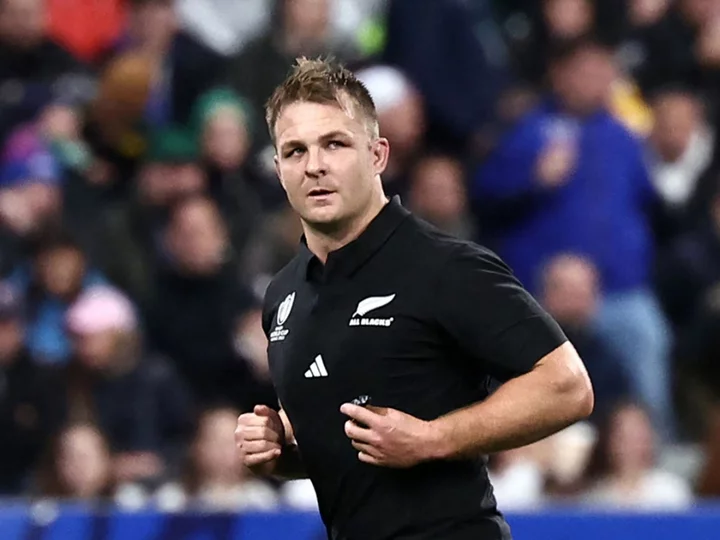
Sam Cane red card: Why was New Zealand captain sent off against South Africa in Rugby World Cup final?
Sam Cane became the first player to be sent off in a men’s Rugby World Cup final after seeing his yellow card upgraded to a red following a review from the TMO bunker during the New Zealand v South Africa match in the Rugby World Cup final. In the first half of the Stade de France showpiece, the All Blacks captain’s shoulder connected with the head of Jesse Kriel. Referee Wayne Barnes initially sent the captain to the sin-bin but, using the bunker system, that was upgraded to a red card soon after. The foul play review officer ruled that it was a shoulder direct to head with significant force and not enough mitigation to remain a yellow card. After the review was complete, Barnes called over stand-in skipper Ardie Savea to deliver the bad news for the All Blacks. He responded in shock: "to red!?" Cane was then seen in agony after learning his fate on the touchline, closing his eyes and rocking back on his chair. Reacting to the decision at half-time, Ireland legend Brian O'Driscoll was adamant Cane deserved the red card, telling ITV Sport: "Any effective tackle is a hinge at the hips, Sam Cane can have no complaints, there's no late dip, he has a clear line of sight, it's considerable force to the head and a very, very clear red card." While All Blacks legend Sean Fitzpatrick reluctantly agreed: "In real time, it's a red card, we have to get on with it." But what are the laws around head contact and high tackles that referees are following and how do they decide on the punishment? Here’s everything you need to know: What are World Rugby’s laws on head contact? Head-on-head contact in the tackle comes under Law 9 of the Laws of Rugby Union, which covers foul play. Law 9.11 dictates “Players must not do anything that is reckless or dangerous to others, including leading with the elbow or forearm, or jumping into, or over, a tackler” and Law 9.13 goes on to say “A player must not tackle an opponent early, late or dangerously. Dangerous tackling includes, but is not limited to, tackling or attempting to tackle an opponent above the line of the shoulders even if the tackle starts below the line of the shoulders.” If a player breaks these laws and the act is deemed to be reckless or dangerous, then the referee is entitled to issue a yellow or red card. World Rugby also clarify the intent of the laws, stating in their guidelines that: “ Player welfare drives World Rugby’s decision making for zero tolerance of foul play, especially where head contact occurs. The focus must be on the actions of those involved, not the injury – the need for an HIA [a Head Injury Assessment] does not necessarily mean that there has been illegal head contact.” What are the punishments for head-on-head contact? Ok, this is where things get technical and debates start to occur. In March 2023, World Rugby issued their latest ‘head contact process law application guidelines’ to guide referees on whether foul play has occurred and how it should be punished. The referee has to go through a four-step process (detailed below) to determine the extent of the foul play and the sanction. The four steps are: Has head contact occurred? Was there any foul play? What was the degree of danger? Is there any mitigation? Step 1 (has head contact occurred?) is relatively straightforward, with head contact including the head and the face as well as the neck and throat area. If any head contact is made at all, we move on to Step 2. Step 2 (was there foul play?) is a touch more complex. The referees are told to consider whether the head contact was either intentional, reckless or avoidable – e.g. the defender is always upright. If it was, the tackler will be penalised and they move on to Step 3. However, if the head contact was deemed not to be foul play, the game continues. Step 3 (what was the degree of danger?) – judged from high to low – determines the initial punishment. A degree of high danger is judged on any of: direct contact rather than indirect, a high-force impact, a lack of control from the tackler, the incident occurring at high speed, the tackler leading with the head/shoulder/elbow/forearm or the tackle being reckless. If the referee judges there to be a high degree of danger, a red card will be shown. Meanwhile, low danger is judged as indirect contact, low force, low speed or no leading head/shoulder/forearm/swinging arm and a yellow card or even just a penalty to the opposition may be awarded. The final step, Step 4 (is there any mitigation?) determines whether the punishment can be reduced by one grade (i.e red card down to yellow card or yellow card down to just a penalty). Mitigation includes a sudden or significant drop in height or change in direction from ball carrier, a late change in dynamics due to another player in the contact area, a clear effort from the tackler to reduce their height or the tackler having no time to adjust. However, mitigation will never apply for intentional or always-illegal acts of foul play. What about the Foul Play Review Officer/Bunker review? Introduced for this World Cup was the Bunker review system. This allows the referee to issue a yellow card to a player, sending them to the sin-bin while play goes on, where a Foul Play Review Official (FPRO) will then take another look at the incident and determine if the yellow card should be upgraded to red, allowing the game to continue rather than a long stoppage to debate this. This is what happened to Curry against Argentina. The referee crosses their arms to indicate a Bunker review will take place. Once a player is in the sin-bin, the FPRO has up to eight minutes to review the decision and decide if it warrants upgrading to a red card. If not, the player will return to the field after their 10 minutes in the sin-bin has elapsed. Read More South Africa become kings of rugby with dramatic World Cup win over greatest rivals Sam Cane, Siya Kolisi and a tale of two captains at the heart of this Rugby World Cup final New Zealand captain Sam Cane opens up on Rugby World Cup ‘heartbreak’ after red card in final New Zealand v South Africa LIVE: Rugby World Cup final score updates as Springboks lead 14-man All Blacks South Africa’s Bongi Mbonambi suffers Rugby World Cup final heartbreak with injury South Africa vs New Zealand: Who is the referee for the Rugby World Cup final?
2023-10-29 15:57
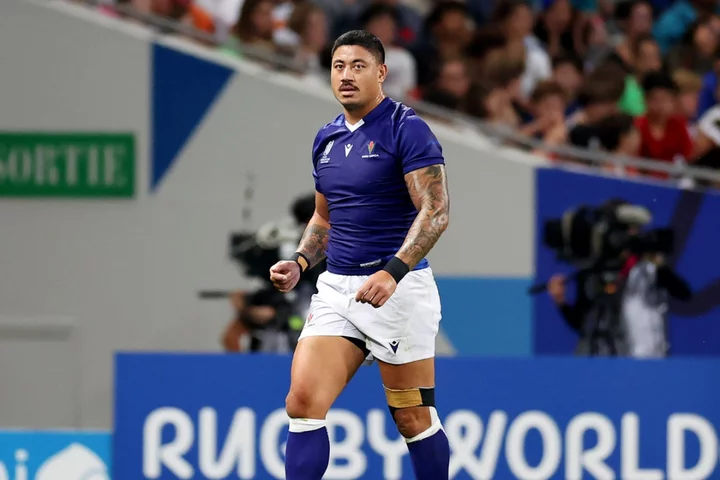
Ben Lam red card: Why was Samoa star sent off against Japan at Rugby World Cup?
Ben Lam became the latest player to see a yellow card upgraded to a red following a review from the TMO bunker during the Japan vs Samoa match at the Rugby World Cup. In the second half of the Pool D contest, Samoan winger Lam’s shoulder connected with the head of Japan back row Lappies Labuschagne while making a tackle, who went off for a HIA. Referee Jaco Peyper initially sent the flyer to the sin-bin but, using the bunker system, that was upgraded to a red card soon after, with the foul play review officer ruling that it was a shoulder direct to head with significant force and not enough mitigation to remain a yellow card. Lam’s dismissal was the seventh red card of the World Cup and is one of a number of disciplinary incidents which have shone a light on the consistency of officiating in this tournament. Arguably the most high-profile moment came on the opening weekend when an England player was shown a red card for the fourth time this year, as Tom Curry was sent off early in his side’s win over Argentina, following a head-on-head collision with Juan Cruz Mallia. However, apparent inconsistency among officials irked many, especially on social media, with other incidents of head contact across the opening weekend not being punished as severely. Later in that same match, Santiago Carreras only received a yellow card despite his leap in attempting to charge down a George Ford kick seeing his hip make contact with the England No 10’s head. During South Africa’s impressive 18-3 win over Scotland, Jesse Kriel’s tackle on Jack Dempsey in which his head clattered into that of his Scottish opponent wasn’t even reviewed by the TMO and wasn’t subsequently cited, while Chile captain Martin Sigren was only sin-binned despite a head-on-head collision while tackling a Japanese attacker. In the second round of action, New Zealand’s Ethan de Groot was sent off for his high hit during the clash with Namibia. But what are the laws around head contact and high tackles that referees are following and how do they decide on the punishment? Here’s everything you need to know: What are World Rugby’s laws on head contact? Head-on-head contact in the tackle comes under Law 9 of the Laws of Rugby Union, which covers foul play. Law 9.11 dictates “Players must not do anything that is reckless or dangerous to others, including leading with the elbow or forearm, or jumping into, or over, a tackler” and Law 9.13 goes on to say “A player must not tackle an opponent early, late or dangerously. Dangerous tackling includes, but is not limited to, tackling or attempting to tackle an opponent above the line of the shoulders even if the tackle starts below the line of the shoulders.” If a player breaks these laws and the act is deemed to be reckless or dangerous, then the referee is entitled to issue a yellow or red card. World Rugby also clarify the intent of the laws, stating in their guidelines that: “ Player welfare drives World Rugby’s decision making for zero tolerance of foul play, especially where head contact occurs. The focus must be on the actions of those involved, not the injury – the need for an HIA [a Head Injury Assessment] does not necessarily mean that there has been illegal head contact.” What are the punishments for head-on-head contact? Ok, this is where things get technical and debates start to occur. In March 2023, World Rugby issued their latest ‘head contact process law application guidelines’ to guide referees on whether foul play has occurred and how it should be punished. The referee has to go through a four-step process (detailed below) to determine the extent of the foul play and the sanction. The four steps are: Has head contact occurred? Was there any foul play? What was the degree of danger? Is there any mitigation? Step 1 (has head contact occurred?) is relatively straightforward, with head contact including the head and the face as well as the neck and throat area. If any head contact is made at all, we move on to Step 2. Step 2 (was there foul play?) is a touch more complex. The referees are told to consider whether the head contact was either intentional, reckless or avoidable – e.g. the defender is always upright. If it was, the tackler will be penalised and they move on to Step 3. However, if the head contact was deemed not to be foul play, the game continues. Step 3 (what was the degree of danger?) – judged from high to low – determines the initial punishment. A degree of high danger is judged on any of: direct contact rather than indirect, a high-force impact, a lack of control from the tackler, the incident occurring at high speed, the tackler leading with the head/shoulder/elbow/forearm or the tackle being reckless. If the referee judges there to be a high degree of danger, a red card will be shown. Meanwhile, low danger is judged as indirect contact, low force, low speed or no leading head/shoulder/forearm/swinging arm and a yellow card or even just a penalty to the opposition may be awarded. The final step, Step 4 (is there any mitigation?) determines whether the punishment can be reduced by one grade (i.e red card down to yellow card or yellow card down to just a penalty). Mitigation includes a sudden or significant drop in height or change in direction from ball carrier, a late change in dynamics due to another player in the contact area, a clear effort from the tackler to reduce their height or the tackler having no time to adjust. However, mitigation will never apply for intentional or always-illegal acts of foul play. What about the Foul Play Review Officer/Bunker review? Introduced for this World Cup was the Bunker review system. This allows the referee to issue a yellow card to a player, sending them to the sin-bin while play goes on, where a Foul Play Review Official (FPRO) will then take another look at the incident and determine if the yellow card should be upgraded to red, allowing the game to continue rather than a long stoppage to debate this. This is what happened to Curry against Argentina. The referee crosses their arms to indicate a Bunker review will take place. Once a player is in the sin-bin, the FPRO has up to eight minutes to review the decision and decide if it warrants upgrading to a red card. If not, the player will return to the field after their 10 minutes in the sin-bin has elapsed. Read More Steve Borthwick questions World Rugby’s silence on red card inconsistency Ethan De Groot red card: Why was All Blacks star sent off at Rugby World Cup? ‘Ruining this World Cup’: TV presenter slams ‘grotesque’ refereeing as Wales beat Fiji Japan v Samoa LIVE: Rugby World Cup 2023 latest updates Scotland make sweeping changes for must-win Romania clash Australia coach says Wallabies can’t handle pressure as Rugby World Cup exit looms
2023-09-29 04:57
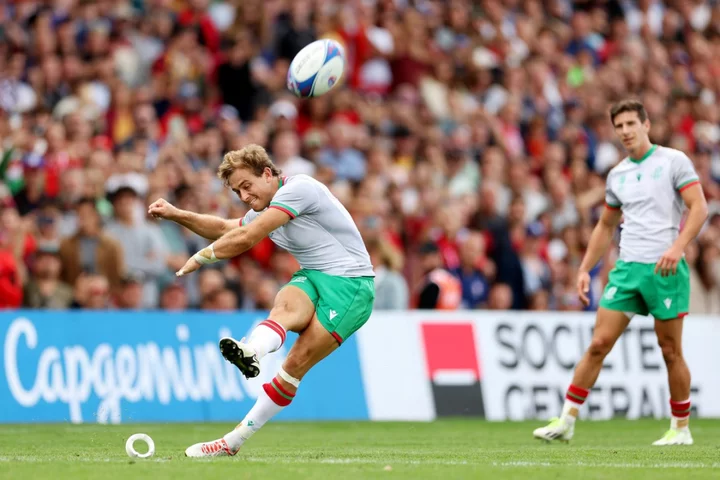
Georgia vs Portugal score: Rugby World Cup latest updates
England will face Chile in the Rugby World Cup this afternoon at Stade Pierre-Mauroy in Lille. Steve Borthwick’s side will be hoping to record a third victory after last weekend’s scrappy bonus-point win against Japan and their opening defeat of Argentina. Owen Farrell returns from his red-card ban alongside 12 other changes, including Marcus Smith at full back, as England aim to give squad members who have featured less so far a good run out. England currently sit top of Pool D with nine points after their first two wins and a win would all but secure a quarter-final place. Los Condores lost their first two matches in what is their first Rugby World Cup and currently sit 22nd in the world rankings compared to England’s sixth. They are currently at the bottom of Pool D with zero points. Follow all of the action here live from Stade Pierre-Mauroy. Plus get the latest Rugby World Cup odds here and tips on England vs Chile here. Read More Marcus Smith backed to shine at full-back as England tackle unfancied Chile Owen Farrell recalls emotional roller-coaster ride of exile from England team
2023-09-23 22:28
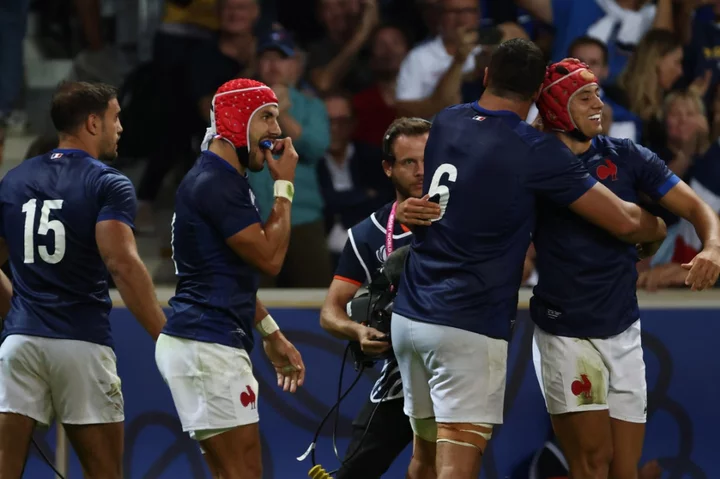
France given huge Rugby World Cup scare by minnows Uruguay
France eventually saw off a brave Uruguay to continue their perfect start to the Rugby World Cup after grinding out a 27-12 win at Stade Pierre-Mauroy in Lille. Anthony Jelonch returned from a lengthy ACL injury absence to captain the team as part of 12 changes to the starting XV which had opened the tournament with an impressive victory over three-time world champions New Zealand in Paris. Les Bleus went in front from an early Melvyn Jaminet penalty after Uruguay had collapsed the scrum. The home fans, though, were then left in stunned silence when Jaminet failed to gather a deep cross-field kick out on the touchline. Nicolas Freitas picked up the loose ball to dart down the left and score in the corner. France responded with a try in the 11th minute when Antoine Hastoy burst through off the scrum, which Jaminet converted and then further extended the lead with another penalty. Romain Taofifenua was sent to the sin bin after the French lock caught Santiago Arata high with his shoulder going into a tackle – which remained at a yellow card after review by the TMO, Welshman Ben Whitehouse, when on another night it could have been deemed a red. Uruguay, playing their first match in Pool A, had a try ruled out in the 35th minute when Felipe Etcheverry dived over, with Tomas Inciarte penalised for an obstruction in the build-up as France went into half-time 13-5 ahead. France thought they had scored a try early in the second half when Gabin Villiere collected a loose ball to run in, but it had been inadvertently knocked on off Anthony Jelonch’s shoulder. Uruguay then reduced the deficit to 13-12 after Baltazar Amaya powered over in the corner and Etcheverry made the conversion. France, though, responded again when Peato Mauvaka touched down under the posts after a fortunate ricochet from Etcheverry’s clearance to settle the home fans’ nerves once again. Any hopes of a comeback from Los Teros were finally ended after Louis Bielle-Biarrey went over in the corner before Sekou Macalou’s breakaway 80-metre try was ruled out by the TMO for kicking through the ruck as Les Bleus failed to claim a four-try bonus point. Read More Elliot Daly eager for England to display attacking talent against Japan Rugby World Cup 2023 TV schedule: Channels, times and how to watch every fixture online South Africa explain use of traffic light signals during Scotland win France v Uruguay LIVE: Rugby World Cup result and reaction South Africa’s ‘X-factor’ will make them tough to beat claims Gareth Thomas France turn to their back-ups as Fabien Galthie rings the changes for Uruguay test
2023-09-15 05:49
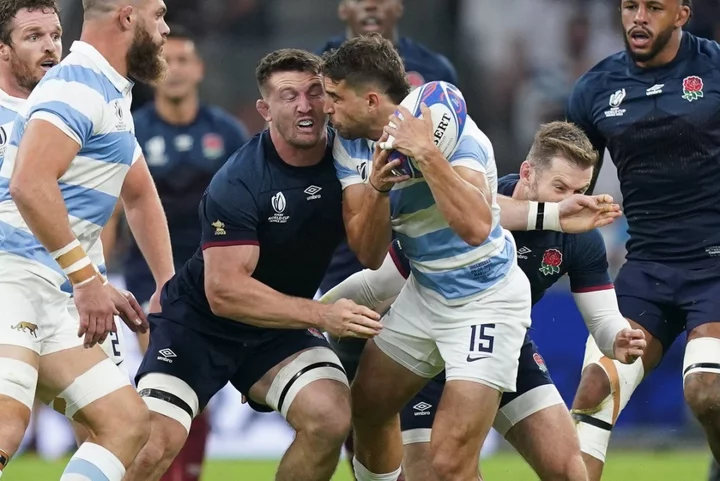
Rugby World Cup: Red card rules explained
Refereeing, head collisions and player safety again made the headlines on the opening weekend of the Rugby World Cup with a number of contentious incidents. The most high-profile came on Saturday when an England player was shown a red card for the fourth time this year, as Tom Curry was sent off early in his side’s win over Argentina, following a head-on-head collision with Juan Cruz Mallia. However, apparent inconsistency among officials irked many, especially on social media, with other incidents of head contact across the weekend not being punished as severely. Later in that same match, Santiago Carreras only received a yellow card despite his leap in attempting to charge down a George Ford kick seeing his hip make contact with the England No 10’s head. During South Africa’s impressive 18-3 win over Scotland, Jesse Kriel’s tackle on Jack Dempsey in which his head clattered into that of his Scottish opponent wasn’t even reviewed by the TMO and hasn’t subsequently been cited, while Chile captain Martin Sigren was only sin-binned despite a head-on-head collision while tackling a Japanese attacker. But what are the laws around head contact and high tackles that referees are following and how do they decide on the punishment? Here’s everything you need to know: What are World Rugby’s laws on head contact? Head-on-head contact in the tackle comes under Law 9 of the Laws of Rugby Union, which covers foul play. Law 9.11 dictates “Players must not do anything that is reckless or dangerous to others, including leading with the elbow or forearm, or jumping into, or over, a tackler” and Law 9.13 goes on to say “A player must not tackle an opponent early, late or dangerously. Dangerous tackling includes, but is not limited to, tackling or attempting to tackle an opponent above the line of the shoulders even if the tackle starts below the line of the shoulders.” If a player breaks these laws and the act is deemed to be reckless or dangerous, then the referee is entitled to issue a yellow or red card. World Rugby also clarify the intent of the laws, stating in their guidelines that: “ Player welfare drives World Rugby’s decision making for zero tolerance of foul play, especially where head contact occurs. The focus must be on the actions of those involved, not the injury – the need for an HIA [a Head Injury Assessment] does not necessarily mean that there has been illegal head contact.” What are the punishments for head-on-head contact? Ok, this is where things get technical and debates start to occur. In March 2023, World Rugby issued their latest ‘head contact process law application guidelines’ to guide referees on whether foul play has occurred and how it should be punished. The referee has to go through a four-step process (detailed below) to determine the extent of the foul play and the sanction. The four steps are: Has head contact occurred? Was there any foul play? What was the degree of danger? Is there any mitigation? Step 1 (has head contact occurred?) is relatively straightforward, with head contact including the head and the face as well as the neck and throat area. If any head contact is made at all, we move on to Step 2. Step 2 (was there foul play?) is a touch more complex. The referees are told to consider whether the head contact was either intentional, reckless or avoidable – e.g. the defender is always upright. If it was, the tackler will be penalised and they move on to Step 3. However, if the head contact was deemed not to be foul play, the game continues. Step 3 (what was the degree of danger?) – judged from high to low – determines the initial punishment. A degree of high danger is judged on any of: direct contact rather than indirect, a high-force impact, a lack of control from the tackler, the incident occurring at high speed, the tackler leading with the head/shoulder/elbow/forearm or the tackle being reckless. If the referee judges there to be a high degree of danger, a red card will be shown. Meanwhile, low danger is judged as indirect contact, low force, low speed or no leading head/shoulder/forearm/swinging arm and a yellow card or even just a penalty to the opposition may be awarded. The final step, Step 4 (is there any mitigation?) determines whether the punishment can be reduced by one grade (i.e red card down to yellow card or yellow card down to just a penalty). Mitigation includes a sudden or significant drop in height or change in direction from ball carrier, a late change in dynamics due to another player in the contact area, a clear effort from the tackler to reduce their height or the tackler having no time to adjust. However, mitigation will never apply for intentional or always-illegal acts of foul play. What about the Foul Play Review Officer/Bunker review? Introduced for this World Cup was the Bunker review system. This allows the referee to issue a yellow card to a player, sending them to the sin-bin while play goes on, where a Foul Play Review Official (FPRO) will then take another look at the incident and determine if the yellow card should be upgraded to red, allowing the game to continue rather than a long stoppage to debate this. This is what happened to Curry against Argentina. The referee crosses their arms to indicate a Bunker review will take place. Once a player is in the sin-bin, the FPRO has up to eight minutes to review the decision and decide if it warrants upgrading to a red card. If not, the player will return to the field after their 10 minutes in the sin-bin has elapsed. Read More Tom Curry ban: How many games will England star miss after red card vs Argentina? ‘Ruining this World Cup’: TV presenter slams ‘grotesque’ refereeing as Wales beat Fiji George Ford plays the pragmatist as England finally come to the boil in Marseille cauldron South Africa explain use of signals during Scotland win National anthems are ruining the Rugby World Cup – they must be changed now Tom Curry banned after red card in Rugby World Cup against Argentina
2023-09-13 18:22
